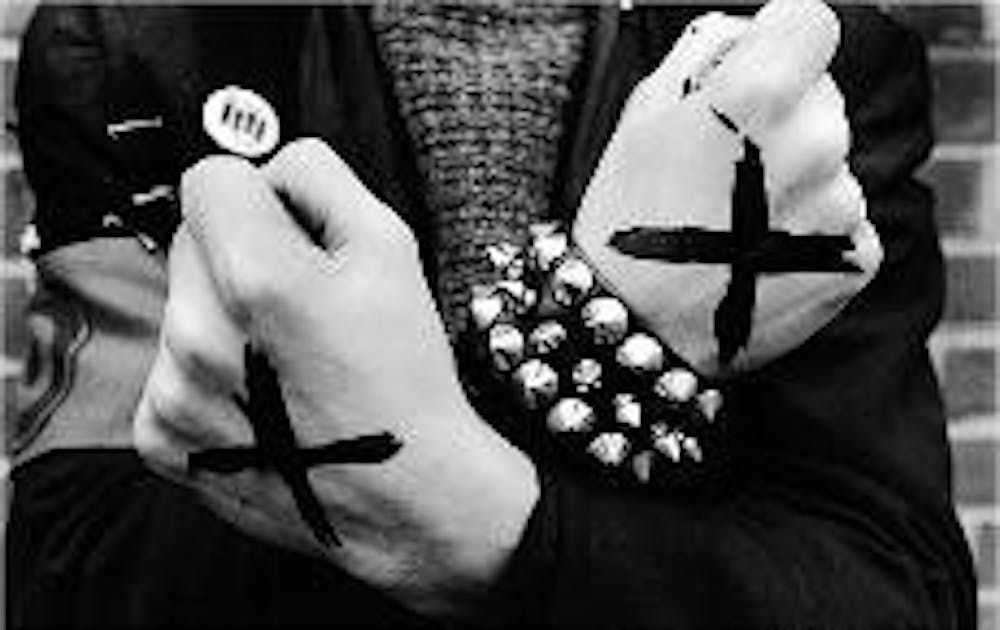The punks have reclaimed Georgetown - at least temporarily. Until March 3, Govinda Gallery's hole-in-the-wall, 34th Street location offers punk enthusiasts a nostalgic sanctuary from the District's snow-covered sidewalks.
Candid, mantle-worthy portraits of Henry Rollins and Ian MacKaye, strategically stuck to the walls with masking tape in punk's minimalist style, survey the sundry smaller squares that capture their combat-boot-clad compatriots.
The exhibit runs concurrent with the release of a book by the same title, "Punk Love." Both showcase photographer and AU alumna Susie J. Horgan's pictures chronicling the birth of the D.C. punk movement.
"It was a pure time for all of us," Horgan said, considering the historic context of her work. "Things were just sort of taking off and beginning. I feel fortunate to have been part of it."
More than a quarter century ago, Horgan walked into a Georgetown H?agen-Dazs looking for a job and a few friends, and instead she found a career. Rollins, 20 years old and the shop's manager at the time, hired her and put her behind the counter that day. Horgan worked there for a year with Rollins and his friend MacKaye, then just 19 years old, while taking a photography class at AU.
"It was the only photography class I ever took," Horgan said. "But I was very interested in the arts. I was a visual media major."
She often brought her camera to work and captured her co-workers keeping boredom at bay during lulls in the workday. Over the year, the three became close friends, a friendship that continues today. In fact, Rollins wrote the foreword to "Punk Love" while MacKaye contributed a transcribed interview with Horgan about her work.
"They were my friends," Horgan said of Rollins and MacKaye. "They were musicians and they would do me favors, pose for my assignments."
Surprisingly, the endearing photographs of a now-typically serious Rollins and politically-minded MacKaye, goofing off in the ice cream shop's freezer and skating behind Horgan's apartment, were done for class, some while Horgan was still mastering the mechanics of her new camera.
"I remember my teacher at the time was always criticizing my pictures, saying 'Can't you take pictures of something else besides these punks?'" Horgan said.
Despite her professor's critique, Horgan continued to photograph her life and what moved her. Even in her current work, photographing the lives of those in Cuba and Haiti and working with the non-profit Shake-a-Leg Miami, she continues her exploration of themes and thoughts that began to take shape back in 1980 - advocating freedom, justice and finding one's voice.
"Do what [you] believe in and what [you] feel," Horgan advised current photography students.
"Try to make the requirement, but don't let anyone dictate what your subject should be - that's your voice, your eye. When you enjoy shooting something and you connect with something as a photographer, don't lose that feeling; keep it alive."
Thanks to Horgan's instincts, her co-workers' boredom and her passion for music, a bit of music history has been kept alive. Her iconic photos of Alec MacKaye - on the back steps of the Wilson Center and his crossed, "X"-ed fists (used by his brother Ian for several LP covers) - continue to inspire new generations of musicians and fans.
This is the first time Horgan has amassed her work into one tribute to the scene, people and city that helped launched her career. Before now, she kept the prints and film in a box tucked away in her home.
"They were personal and the only people who had access to them were Ian and Henry," Horgan said. "They were the first to publish them and the few that they did really affected people."
The reason these pictures are so personal for the photographer and so powerful for viewers is that moments of youthful energy and enthusiasm, and the birth of an enduring, influential art form, have been frozen in time.
For anyone who has ever blasted Minor Threat's discography or the "Flex Your Head" compilation, both of which murmur softly throughout the gallery, it is impossible to look at stills of MacKaye, frozen mid-ollie or mid-roar, and not have a huge, silly smile stretch across one's face.
"It's really beautiful to hear, letting these images out of the bag and seeing people's reaction to them," Horgan said, aware of her work's effect on people.
Although the gallery is not crowded with curious fans, the few who are there are in good company. Whether it is fans over 40, laughing audibly at Rollins with plastic spoons over his eyes, or fans under 20, sighing as they lament the Wilson Center's demise or Fugazi's "hiatus," the exhibition's name becomes very appropriate.
Why call it "Punk Love?"
"Because it was a community where everyone loved one another, and sometimes this community could be misunderstood," Horgan said. "There was a real shared love"





